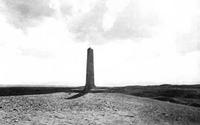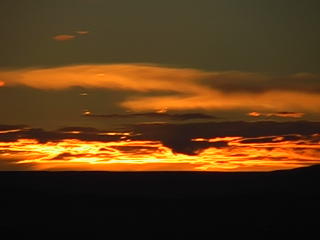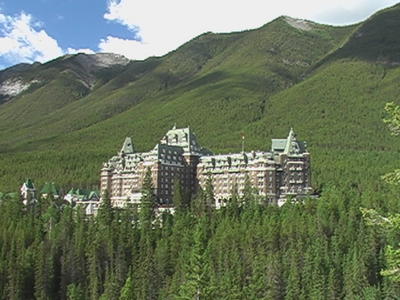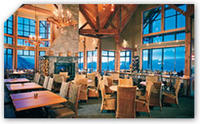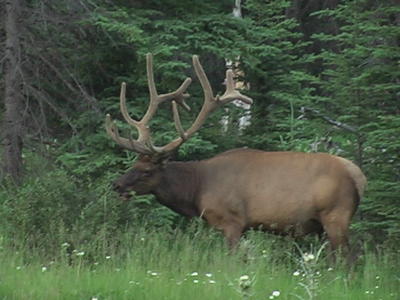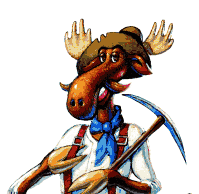 100th Anniversary of the Alaska Gold Rush
100th Anniversary of the Alaska Gold RushAccording to the Alaska license plates, the state is celebrating the 100th anniversary of the big gold rush in the Klondike. I took this to mean that I should bring all of my gold to Alaska and return it, so we did our best.
However, I have now discovered that the 100th anniversary was really in 1998. This says a lot about Alaskans. They don’t particularly want their brethren from the “southern 48” to know too much about what’s going on up here. And they are not necessarily too quick on the uptake of new ideas.
They don’t want to be told about their celebratory license plate being five years out of date—fact is, they don’t particularly want to be told about how anything is done elsewhere in the United States. Yet the folks couldn’t be much nicer.
That’s because they are Alaskans and damn proud of it.
Just about every other business has “Alaska” in the name. Every town seems to be required to have at least one of every service business started with the word “Alaska.” Guaranteed you’ll find “Alaska Plumbing & Supplies” and “Alaska Paint & Body Shop.” You’ll never forget you’re in Alaska when you’re in Alaska. Alaska is Texas2. Texas is the lone star state, Alaska has eight stars on its flag—seven in the big dipper and the North Star thrown in for good measure.
But before I paint a picture of false braggadocio, let me say the most of the pride is well-justified by Alaska’s unspoiled natural beauty. Amazing and inspiring are its ever-present snow-peaked mountains and its vast stretches of wilderness. Spellbinding is the drop by drop disappearance of its massive blue-ice glaciers into streams, run-offs, lakes and the Pacific—just as enticing to know it will rebuild again this winter, but not quite as big (global warming, you know.)
And the pride in its unrivaled parade of birds, animals and sea creatures is well deserved.
So if there is a little Alaska-arrogance in all the people of the State, you get the clear feeling that it’s because they all know. They know they’ve got it—and we don’t. Worse, we can’t get it back unless we move up there. They’ve cleverly installed a 50° below zero protective zone to make sure that doesn’t happen.
Yeah, they’re nice to us because they all feel a little sorry for us!
But I digress. Vacation 2005 took months to plan and execute. It would have been possible to walk into motels and hotels without reservations in many cases. However the thought of arriving in a town and starting the search for a motel at 8 pm was something I wasn’t willing to tackle on this trip. FYI, motels cost about three times as much out West as they do in the South and Midwest. That was my biggest expense of the trip by far.
Originally planning for Glacier National Park and Banff, somewhere along the way I decided to add Alaska—Juneau. But because train connections and ferry schedules didn’t match and I didn’t want to spend four days on a train and ferry, I switched to Anchorage, Denali National Park and the Kenai Peninsula.
 Glacier National Park, as had been the two times before, was absolutely gorgeous. This is among the most beautiful spots in this country, as far as I am concerned. We flew into Kalispell and checked into our motel (the best price of the trip at $75!) at the gate of the West Entrance to the park.
Glacier National Park, as had been the two times before, was absolutely gorgeous. This is among the most beautiful spots in this country, as far as I am concerned. We flew into Kalispell and checked into our motel (the best price of the trip at $75!) at the gate of the West Entrance to the park. He gave us some tips on where to see wildlife on some of the back roads of Glacier. We saw a bunch of deer, and perhaps a bear, but too far away to definitely confirm.
One main hope was to see bears. When we first went there in 2001, we saw five bears, giving us false hope ever since. We hadn’t seen a bear in all the ensuing years. True to form, we didn’t see a bear in Glacier this time either.
There is an amazing 52 mile road through the park that skirts the edge Glacier’s mountains and overlooks valleys several thousand feet below, often pretty much straight down outside the car’s side window. It is the “Going to the Sun Road.” When we visit, we usually drive this road three or four times.
The first such ride was the day after we bought the picnic supplies with the intention of an outdoor lunch. We arrived at the pre-chosen lunch spot (Sun Point Nature Trail) much later than we anticipated, and it must have been at least 3:30. Contrary to its name, the bright sunny day, as often happens on the “other side of the mountains” quickly turned chilly and windy, complete with rain.
I despise eating in a car, but since we were starving, we struggled to make sandwiches out of the somewhat soggy (from the cooler) turkey and ham we bought. Nothing worse than juggling sandwiches, mayonnaise and mustard jars, potato chips, cheese puffs, chocolate chip cookies and a Budweiser in a car. Judi learned something—she hates waterlogged ham. I, personally, discovered that cheese puffs are an excellent entrée.
However, as soon as we finished eating, it cleared up. So we traveled on. Judi drove as I dozed. Sometime later, I was awakened for road directions, which I will not get into here. Let it suffice to say on our way back to the road we wanted, we spotted a roadside marker for Lewis & Clark’s Camp Disappointment.
Camp Disappointment

“Lewis and three companions, George Drouillard and the Field brothers, Joseph and Reubin, spent July 22 to July 26, 1806, at Camp Disappointment, the northernmost campsite of the Lewis and Clark Expedition. Lewis hoped to determine how far north the Marias River extended. President Jefferson desired proof of a tributary of the Missouri River that extended to 50°-north latitude, giving the United States a claim to a more northern boundary. Had this been the case, the natural boundaries of the Louisiana Purchase would have been extended.”
The sun was going down (about 10 pm) as we read the marker about the campsite, some five miles north of this spot. Up on a hill, maybe ½ mile away, I saw a monument. We drove up the winding dirt road through someone’s farm to this site, a small parking lot with “the” monument. It was a nice 15’ high stone monument with an attached plaque (bronze?)
Monument to Meriwether Lewis, along Highway U.S. 2 about 22 miles west of Cut
Bank, Mont. The northernmost point reached by the expedition lies a few miles
farther north. The mountains in the background are in Glacier National Park.
(National Park Service (Mattison, 1958).)
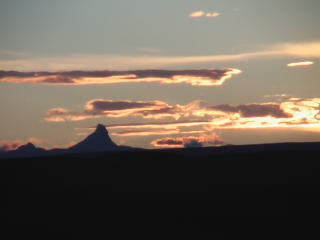
Still driving back to the motel, we arrived at Browning, MT shortly after our peaceful sunset interlude. As frequently happened on this trip, since it was light until so late, our dinner schedule was very confused on this trip. It fequently became scrambling for a place still serving at 10 pm or later. Such was the case in Browning.
The pow-wow is the best of times for Browning. The teepees are a big improvement over the regular housing. The sad fact is that Indian housing on reservations throughout the west is a patch work of pathetic bungalows held together with anything handy. Additions to the “houses” consist of parking a rusty old trailer(s) outside the kitchen door.
“Downtown” Browning comprises several out-of-business stores with grime-covered glass or boarded up windows mixed in with one or two Indian souvenir shops, an Blackfoot Museum, a gas station, a couple of motels from the 40’s, including a motel where you actually sleep in a teepee. And, there to serve our dinner needs:
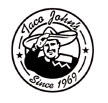
We had never heard of Taco John’s, but have now learned it has over 400 locations, this one owned by savages, no doubt. Taco John succeeds by serving large portions of tasty, messy Tex-Mex food—emphasis on the large or maybe on the messy. Approaching 11 pm, the drive through was the only option. We ordered three entrées to share, since we were very hungry.
I previously indicated how “eating in the car” ranks on my list of favorite things. Eating a sloppy Mexican dinner from three flimsy foam boxes, dripping with TJ’s secret sauces, that ran down my arms was just the best!
I believe the Indians have found an excellent way to get back at the whiteskins.
STARS
When Scott met us at the airport the first time we visited Glacier, he stopped in a field to show us the sky. For one reason or another, we didn’t do it again until this trip. We still had about 80 miles to get back to our motel. Along the way, about 1 am, we stopped in a clearing beside the road. Turning off all the lights, it is pitch black in the middle of Montana. But the magic is in the sky. One of the most incredibly beautiful sights I’ve ever seen.
The entire sky is pinpointed by millions of bright stars. If you think you’ve seen a lot of stars on a brilliantly clear night take that view and multiply it by about 100, and you’ve got a Montana sky. It is breathtaking. We leaned against the car and just stared up. I saw one shooting star.
It’s a scene that can’t be captured in the greatest of photographs by the world’s greatest photographers. It is for yours eyes only. Your entire field of vision is filled with a true million points of light.
THE FOURTH OF JULY
We were due to leave on the Fourth of July for Waterton, Canada, the adjoining part of the park on the Canadian side. Checkout was at 11am. That was the day we got up early, around 5 am, to try to view wildlife in some of the spots Scott recommended. We didn’t see anything (surprise!) but drove out to Polebridge.
Polebridge is a “town” about 30 miles from “East Glacier.” East Glacier is a town of four motels, eight souvenir shops and a couple of restaurants. Polebridge is a town of one building at the end of an unpaved dusty road. Imagine an old west town out of a western movie. Pick one of those buildings and paint Polebridge Mercantile over the front porch and you’ve got the Polebridge General Store, which is Polebridge.
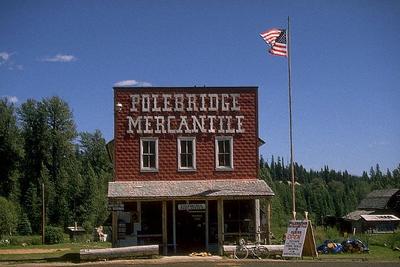
The amazing thing about this store is that it bakes some of the greatest breakfast pastries in the world! Yummy yum yum. We ate our breakfast in the store at the mandatory checkers table. We then decided to head to Kintla Lake, a mere 17 miles away. This ride took an hour over the bumpiest unpaved road. But as we arrived at the lake—crystal clear and surrounded by mountains , of course—we were surprised to find, a parking lot of about eight cars and campers who had spent the night there. It was a delightful time.
We had been warned not to come back to Polebridge at noon if we wanted to get through—in fact, stay away from 11:30 on. Because of the giant Fourth of July parade lasting an hour, attended by a couple of thousand people--the street would be clogged.. You have to understand that Polebridge has a population of about 18.
Well, naturally, we got there at noon. And I wouldn’t have cared at all, except we were well beyond checkout time at the motel. I was scrambling to get a phone call through to the motel as the parade went by and went by.
The estimate of viewers was a little high; there may have been 200 people watching as the parade of a few pick-up trucks drove by. One with a bluegrass band, another with a group of girls in bridal outifts,singing. "Going to the Chapel" and a third with a gospel singing group. The parade was unending. Because the trucks would drive down the long dusty street to the general store, turn the corner; drive back to the highway and down the dusty road again and again. What a treat!
We eventually escaped and the motel manager was quite upset. Too bad. He just didn’t understand what Polebridge was like on the Fourth of July.
Here are some sites for QuickTime Glacier panoramic photos –taken while we were there, but we didn’t take them!
http://www.nps.gov/glac/gallery/070305.htm
http://www.nps.gov/glac/gallery/070305b.htm
http://www.nps.gov/glac/gallery/070405b.htm
http://www.nps.gov/glac/gallery/070405a.htm
On to Waterton
Waterton Lakes National Park (Canada) is a beautiful mountain park adjoining Glacier NP across the border. It boasts the oldest rocks in the Rockies in this waterfall.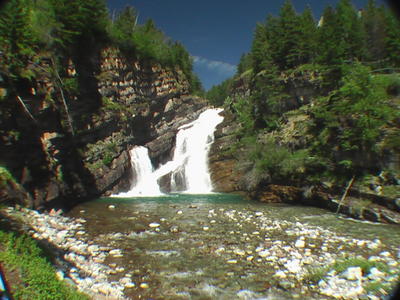
The Cameron Falls are located in the townsite of Waterton Village. This serene cascade is well lit at night for viewers enjoying a peaceful evening stroll. These falls are also the site of the oldest rock in the entire Canadian Rocky Mountain range! Precambrian bedrock dating 1.5 billion years (1500 million years) old has become exposed and is visible near the falls. This is one of many examples of Waterton's amazing geology!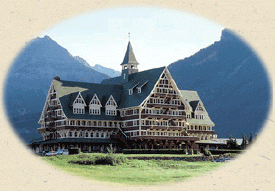
The town itself is filled with motels, hotels, restaurants and souvenir stores. It is also the home of the Prince of Wales hotel, featured in many commercial over the years. We shopped the stores—looked like one or two may have gone bye-bye, and had a horrible Italian lunch.
The town was experiencing a “snowstorm” of some local wildflower seeds that blow in the breeze and cover everything. We headed off to Banff on the back route. We 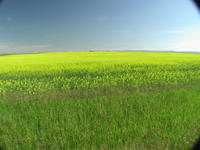 passed incredible miles-long fields of yellow canola flowers. We had a horrible Chinese dinner, through small unique towns and then the sprawling Calgary metropolitan area.
passed incredible miles-long fields of yellow canola flowers. We had a horrible Chinese dinner, through small unique towns and then the sprawling Calgary metropolitan area.
The 15 miles to the west of the city was dotted solidly with thousands and thousands of houses, with zero lot lines and no trees for miles. The growth rate here must be phenomenal. All the more reason to appreciate the grandeur of Canadian Rockies, less than an hour away.

